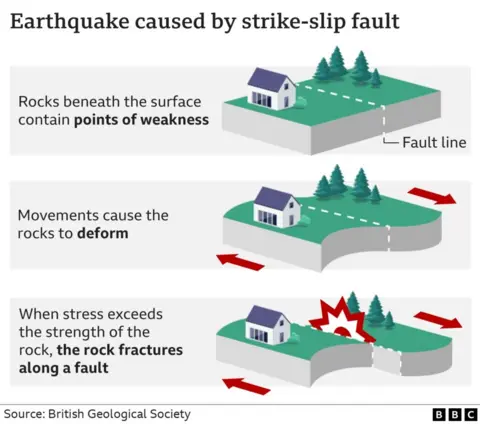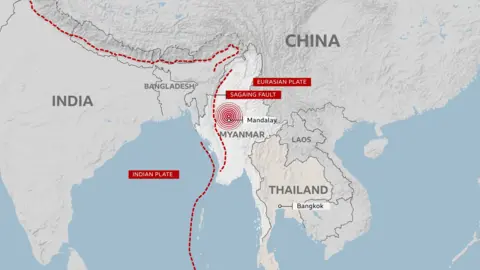Climate and Science correspondent, BBC News
On Friday, a large earthquake in Myanmar caused more than 1,000 deaths and led to the collapse of many structures.
Although Myanmar is a high -risk area of earthquakes, the damage to the buildings was widespread.
On the other hand, Bangkok is not an earthquake. The Thai capital is more than 1000 km (621 miles) from the earthquake center on Friday – however, an incomplete building was fell in the city.
Here we will explain the reason for this earthquake, and how it managed to have such a strong effect away.
What caused the earthquake?
The upper layer of the Earth is divided into different sections, called tectonic panels, which all move constantly. Some move alongside each other, while others are higher and below each other.
This is the movement that causes earthquakes and volcanoes.
Myanmar is one of the most “active” geological areas in the world because it is located over nearly four of these tectonic paintings – the European plate, the Indian painting, the Sonda plate and the Burma plate.
The Himalayas was formed by the Indian plate that collides with the European painting, and the 2004 tunaami as a result of the movement of the Indian plate under the Burma paintings.
Dr. Rebecca Bell, a reader of the Tektonians in College Imperial College in London, said that to accommodate all this movement, make mistakes – cracks in the rock – allowing tectonic panels to “slip.”
There is a big mistake called the epic error, which is cut directly across Myanmar from north to south and is more than 1,200 km (746 miles).
Early data indicates that the movement that caused a 7.7-degree Friday earthquake was a “slide”-where two horizontal masses move along each other.
This is in line with the typical movement of the epic error.
While the paintings move around each other, they can become stuck, and build friction until they are suddenly released and the ground turns, causing an earthquake.

Why the earthquake poetry away?
Earthquakes can occur at a speed of up to 700 km (435 miles) below the surface. This was only one 10 kilometers from the surface, making it very shallow. This increases the amount of shaking on the surface.
The earthquake was also very large – 7.7 at the moment. It produced more energy than the atomic bomb that decreased on Hiroshima, according to the American geological survey.
Dr. Bell said that the size of the earthquake was due to the type of error.
“The straight nature (of error) means that earthquakes can be torn on large areas – and the more the error of the error, the more the earthquake,” she explained.
“There were six earthquakes of six size or larger in this region in the past century.”
This straight error also means that a lot of energy can be transferred length – which extends to the south by 1200 km towards Thailand.
How to have an impermissible surface is also determined by the soil type.
In soft soil – which is built by Bangkok – seismic waves (earth vibrations) slow, accumulate, and increase their size.
So the Bangkok geology would have made the Earth shake more intense.

Why only one skyscraper collapsed in Bangkok?
While dramatic shots of tall buildings appeared in Bangkok, swinging during the earthquake – Water knocks from swimming pools on the roof It seems that the incomplete headquarters of the Bangkok General References Office in Bangkok is the only skyscraper that has collapsed.
Before 2009, Bangkok did not have a comprehensive safety criterion for building seismology, according to Dr. Christian Mouliaj Chuktipe, the first lecturer in earthquake engineering in imperial College London.
This means that the old buildings would have been particularly weakened.
This is not unusual, because the earthquake -resistant buildings can be more expensive to build and Thailand, unlike Myanmar, not facing earthquakes frequently.
Dr. Emily, Professor of Architecture at the University of Cambridge, indicated that old buildings can be enhanced, as in California, West Canada and New Zealand.
However, the building that collapsed new – in fact, was still under construction when the earthquake struck – and the updated construction standards were applied.
But after studying the video, Dr. Málaga-Cuquitaype said it seemed that the construction of a “flat panel” was preferred-which was no longer recommended in earthquake areas.
The “flat slab” system is a way to build buildings where floors are made to rest directly on the columns, without using packages.
“Imagine a table supported by the legs only, with no additional horizontal pillars under it.
“Although this design has costs and architectural benefits, it works badly during earthquakes, and it often fails in a fragile and gap (almost almost explosive).”
What about the buildings in Myanmar?
Mandalay in Myanmar was much closer to the place where the Earth retreated and would have more severe vibration than Bangkok.
Although Myanmar is regularly suffering from earthquakes, Dr. Ian Watsenson, a lecturer in Earth Sciences at the University of Royal Holway, believed that it is unlikely that many buildings are resistant to earthquakes.
“General poverty, the main political turmoil, along with other disasters – for example the Indian Ocean tsunami – diverted the country's attention from focusing on the unpredictable risks of earthquakes,” he said.
“This means that in many cases, construction design symbols are not applied, and construction occurs in areas that can be vulnerable to reinforced seismic risks, for example the plains of flood and sharp slopes.”
Parts of Mandalaay and their buildings are also located along the flood of the Airudi River. This makes them very vulnerable to a process called evaluation.
This occurs when soil has a high percentage of water, shaking leads to the loss of deposits and behaves like a liquid. This increases the risk of landslides and construction, as the land can no longer keep it.
The doctor has warned that there is a “always an opportunity” to add more damage to the buildings near the error line due to the final tremors – the earthquakes that follow the earthquake, which could be the result of the sudden transfer of energy to the nearby rocks.
“Most of the time of the final tremors is smaller than the main shock, and it tends to decrease in size and frequency over time,” she said.
Additional reports by Vicky Wong




